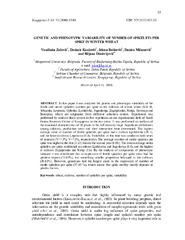Приказ основних података о документу
Genetic and phenotypic variability of number of spikelets per spike in winter wheat
| dc.creator | Zečević, Veselinka | |
| dc.creator | Knežević, Desimir | |
| dc.creator | Bošković, Jelena | |
| dc.creator | Mićanović, Danica | |
| dc.creator | Dimitrijević, Biljana | |
| dc.date.accessioned | 2024-03-05T13:43:38Z | |
| dc.date.available | 2024-03-05T13:43:38Z | |
| dc.date.issued | 2009 | |
| dc.identifier.issn | 1450-9636 | |
| dc.identifier.uri | https://www.pmf.kg.ac.rs/KJS/en/volumes/kjs31/kjs31zecevicknezevic85.pdf | |
| dc.identifier.uri | http://RIVeC.institut-palanka.rs/handle/123456789/854 | |
| dc.description.abstract | In this paper it was analyzed the genetic and phenotypic variability of the fertile and sterile spikelets number per spike in ten cultivars of winter wheat (KG-56, Srbijanka, Lepenica, Oplenka, Ljubičevka, Jugoslavija, Zagrepčanka, Nizija, Slavonija and Baranjka), which are originated from different selection centers. Experiment was performed by random block system in five repetitions on the experimental field of Small Grains Research Centre of Kragujevac in the two years. It was performed an analysis of the examined characteristics of 50 plants in the full maturity stage. Significant differences among cultivars, production years and their interaction were determined. The highest average value of number of fertile spikelets per spike had a cultivar Ljubičevka (20.7), and the lowest cultivar Lepenica (18.4). Variability of this trait was similar in both years of research (V=7.3%; V=7.8%, respectively). The average number of sterile spikelets per spike was higher in the first (1.12) than in the second year (0.96). The lowest average sterile spikelets per spike established at cultivars Ljubičevka and Jugoslavija (0.5), and the highest at cultivars Zagrepčanka and Nizija (1.6). By the analysis of components of phenotypic variance it was established that in expression of fertile spikelets per spike years had the greatest impact (35.05%), but something smaller proportion belonged to the cultivars (20.62%). However, genotypes had the largest share in the expression of number of sterile spikelets per spike (57.45 %), which means that spike sterility mostly depends to genetic factors. | sr |
| dc.language.iso | en | sr |
| dc.publisher | Univerzitet u Kragujevcu : Prirodno-matematički fakultet Kragujevac | sr |
| dc.rights | openAccess | sr |
| dc.rights.uri | https://creativecommons.org/licenses/by/4.0/ | |
| dc.source | Kragujevac Journal of Science | sr |
| dc.subject | wheat | sr |
| dc.subject | cultivar | sr |
| dc.subject | number of spikelets per spike | sr |
| dc.subject | variability | sr |
| dc.title | Genetic and phenotypic variability of number of spikelets per spike in winter wheat | sr |
| dc.type | article | sr |
| dc.rights.license | BY | sr |
| dc.citation.epage | 90 | |
| dc.citation.spage | 85 | |
| dc.citation.volume | 31 | |
| dc.identifier.fulltext | http://RIVeC.institut-palanka.rs/bitstream/id/2715/bitstream_2715.pdf | |
| dc.identifier.rcub | https://hdl.handle.net/21.15107/rcub_rivec_854 | |
| dc.type.version | publishedVersion | sr |


